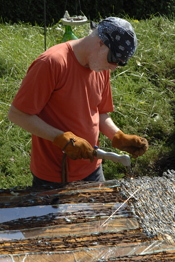|
January 11, 2007
SIX MONTCLAIR ARTISTS COLLABORATE ON BEN SHAHN GALLERIES EXHIBIT
—“Six Men Working: Sanctuary” explores interplay of certainties and uncertainties in contemporary life
 |
| Artist Charlee Swanson at work |
Six New Jersey artists working in various media join together to examine the concept of sanctuary, whether a physical place or a state of mind, in a new exhibit at the Ben Shahn Galleries at William Paterson University in Wayne from January 28 through March 2, 2007. Gallery hours are Monday through Friday, 10 a.m. to 5 p.m. Admission is free. An opening reception for the exhibit will be held on Sunday, January 28 from 2 to 4 p.m. in the Galleries.
“Six Men Working: Sanctuary,” on view in Ben Shahn’s expansive, glass-enclosed Court Gallery, is the fourth collaboration by Montclair-based artists Jose Camacho, Peter Jacobs, Drew Knapp, Ron Ridgeway, Jay Seldin and Charlee Swanson. The artists, who Ridgeway initially assembled for a group exhibit in reaction to the September 11, 2001 terrorist attacks, continue to periodically work together to explore artistic concepts.
“The word ‘sanctuary’ carries many meanings and conjures many images and emotions,” says Nancy Einreinhofer, director of the Ben Shahn Galleries. “It is a safe place, a peaceful refuge, a sacred place, a place apart. It might be a physical place but it might also be a state of mind. It is a word, a theme, that provides these artists with an opportunity to explore the interplay of certainties and uncertainties in contemporary life.”
Each of the six artists uses different mediums in very distinctive ways to communicate his ideas. For example, Jay Seldin’s photographic series “Calm Waters” evokes a peaceful and calming energy. According to the artist, the “slow undulating movement of the waves found in the Baltic Sea provides a sense of sanctuary.” These straightforward images capturing the real world are, says Einreinhofer, “at the same time, somewhat surreal in the vastness they record and therefore connected to the unconscious, the life of dreams, the unknown and unpredictable.”
In contrast, a photographic series/ installation by Peter Jacobs titled “Still Moving” features video stills of the artist’s daughter Zoë, cheerfully free form dancing. Jacobs has long used collage, assembling his visual images. “Here,” says Einreinhofer, “we have a single subject, figure on ground, presented in a linear-collaged fashion through site installation. The basic image units might document nostalgia for childhood innocence while acting simultaneously as building blocks of a narrative to carry us forward. Zoë shows us the gesture of great joy to be had in life.”
Three painters, Jose Camacho, Drew Knapp, and Ron Ridgeway, exercise a provocative dialogue between the painting process and the image, each in his own way. All three artists recognize the importance of place as each explores the multiple connotations of materials.
Jose Camacho was born in Puerto Rico and here uses the iconic image of his home island much in the way Jasper Johns used the American flag. “The surfaces of his paintings might be saturated or reflective but the concept (and what is ‘home’ if not a sanctuary?) urges us to examine our patterns and methods of ascribing meaning,” Einreinhofer explains.
Drew Knapp’s paintings evolved from an idea embedded in an etching he made some twenty years ago. He writes: “My recent painting and drawing is inspired by this print, as well as by apprehensive sensations and memories of air / water / sand / waves / twigs / space in between / outer space / inner space / stars / constellations / surveys / maps / arteries / impermanence... all of which relate to the following question: Where within a vast and cruel universe may sanctuary be found?“
The sanctuary of nature in the form of woods, wetlands, and wildlife is the starting point for the abstract landscapes of Ron Ridgeway executed in mixed media. In the “Orono Series,” named for the place of his residency in northern Minnesota, Ridgeway uses acrylic paint with collage and graphite. “Our prehistoric ancestors expressed the world they experienced through paintings on the walls in their caves,” he says. “I look outside my studio window and cannot see the beasts – but feel the danger. My work is about those feelings.”
Charlee Swanson seeks to confront and confuse the viewer’s automatic response to the known materials of glass and steel. “My work is primarily about the materials,” he says. “I use only broken glass and steel – recycle and reuse discarded materials from glass shops and metal fabricators. The original purposes of the glass and metal are no longer recognized by the viewer as objects of support, protection, and construction.”
The exhibit is one of three shows currently on view in the Ben Shahn Galleries. On view in the East Gallery is “More Than Meets the Eye: Insight into the Artistic Process,” which explores how artists imagine, recognize, and bring their art to fruition; the exhibit is curated by Sandy DeSando.” The South Gallery features “George Tice: Paterson II,” an exhibit of black and white prints of Paterson by the award-winning New Jersey photographer.
The exhibit is made possible in part by funds from the New Jersey State Council on the Arts/Department of State, a partner agency of the National Endowment for the Arts.
The Ben Shahn Galleries are wheelchair-accessible. Large-print handouts are available. For additional information, please call the Ben Shahn Galleries at William Paterson University at 973-720-2654.
###
www.wpunj.edu
|







